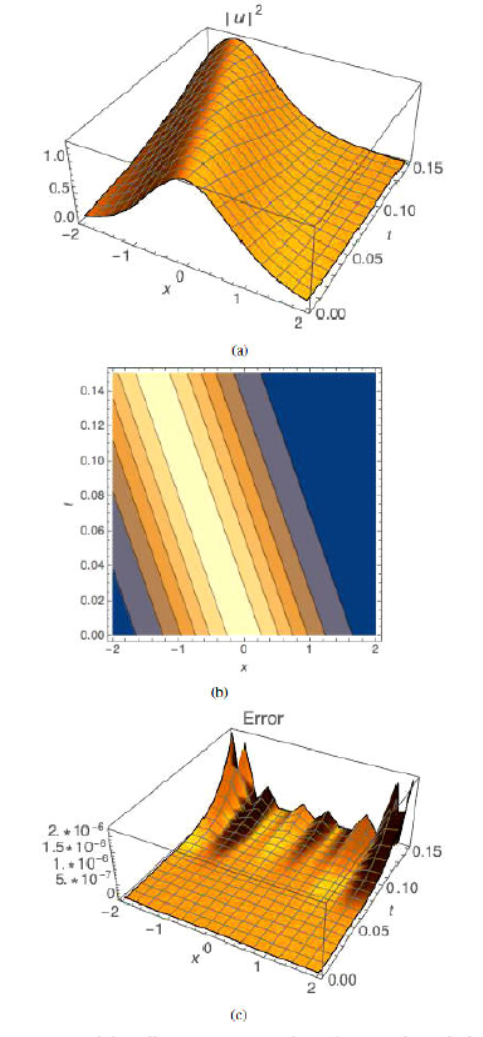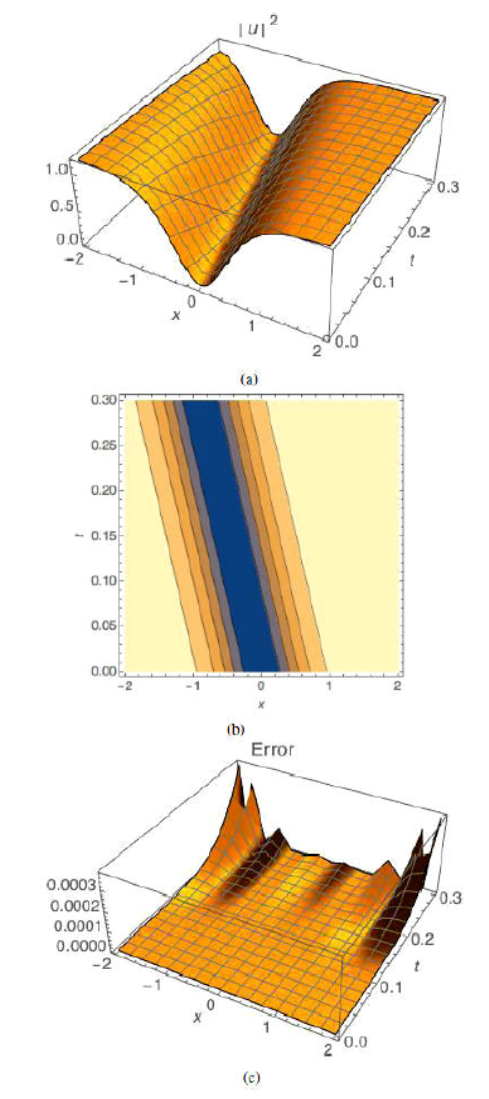Research
Gravitation, Mathematical Physics and Field Theory
Optical soliton perturbation with spatio-temporal dispersion having
Kerr law nonlinearity by the variational iteration method
O. González-Gaxiolaa
A. Biswasb
c
d
e
A. Kamis Alzahranic
M. R. Belicf
aDepartamento de Matemáticas Aplicadas y
Sistemas, Universidad Autónoma Metropolitana-Cuajimalpa, Vasco de Quiroga 4871,
05348 Mexico City, Mexico. ogonzalez@correo.cua.uam.mx
bDepartment of Physics, Chemistry and
Mathematics, Alabama A& M University, Normal, AL 35762-7500, USA.
cDepartment of Mathematics, King Abdulaziz
University, Jeddah-21589, Saudi Arabia.
dDepartment of Applied Mathematics, National
Research Nuclear University, 31 Kashirskoe Shosse, Moscow-115409, Russian
Federation.
eDepartment of Mathematics and Statistics,
Tshwane University of Technology, Pretoria-0008, South Africa.
f Science Program, Texas A& M University at
Qatar, PO Box 23874, Doha, Qatar.
Abstract
This paper studies optical soliton perturbation that appears with Kerr law
nonlinearity having spatio-temporal dispersion. The numerical scheme adopted is
the variational iteration method. The perturbation terms are of Hamiltonian type
and stem from inter-modal dispersion, self-steepening and nonlinear dispersion.
Both bright and dark solitons are taken into consideration.
Keywords: Nonlinear Schrödinger equation; Kerr law nonlinearity; variational iteration method; optical solitons solutions; perturbation
PACS: 02.30.Jr; 02.60.Cb; 45.10.Db; 44.05.+e
Introduction
The study of optical soliton perturbation has been going on for several decades now
[1-4]. This has led to the visibility of several
interesting results both from analytical and numerical perspective. While there
exists an abundance of analytical tools to handle the governing equations, there
exists only handful few numerical schemes that are applicable and are visible. These
range from finite element method, finite difference method, Adomian decomposition
scheme, Laplace-Adomian decomposition, and the variational iteration method (VIM).
This paper implements VIM to address soliton dynamics, modeled by the nonlinear
Schrödinger’s equation (NLSE), with a few perturbative effects. These perturbation
terms come from intermodal dispersion, self-steepening effect, and nonlinear
dispersion. The NLSE also includes the effect of spatio-temporal dispersion (STD) in
addition to the usual chromatic dispersion (CD). The inclusion of STD, in addition
to CD, makes the model well-posed. Both bright and dark solitons will be studied in
the current work. The surface plot, contour plot, and the error plots are all
presented for both of these solitons. The details of VIM and its application to the
model are inked in the rest of the paper.
Governing model
The dimensionless form of NLSE with STD Kerr law nonlinearity is given by (5)
iut+auxx+buxt+cFu2u=iαux+βu2ux+γu2xu
(1)
In Eq. (1), u(x,t) represents a complex field envelope, and x and t are spatial and temporal variables, respectively. Here, the coefficient a is the group velocity dispersion (GVD) and b is the STD the coefficient of c represents the Kerr law nonlinear term that is modeled by the functional F(|u|2)=|u|2. This type of nonlinearity originates when a light wave in an optical
fiber is subjected to nonlinear responses [6]. Moreover, in the perturbative term of Eq. (1), the
first term represents the inter-modal dispersion (IMD), the second term is the
self-steepening effect and finally the last term accounts for another version of
nonlinear dispersion (ND). This perturbed NLSE is going to be studied by the VIM in
this paper, for Kerr law nonlinearity with fully nonlinear perturbation terms.
Bright optical solitons
The bright optical soliton solution to Eq. (1) is given by [5]:
u(x,t)=Asech[B(x-νt)]ei[-κx+ωt+θ].
(2)
Here, ν is the soliton velocity, κ is the soliton frequency, ω is the angular velocity, and θ is the phase center.
The amplitude A of the soliton in this case is given by
A=2(ω+ακ-aωκ+bκ2)c-βκ
(3)
and the width B of the soliton is given by
B=ω+ακ-aωκ+bκ2b-aν.
(4)
The velocity ν of the soliton in relation to the coefficients that appear in the
Eq. (1) is
ν=aω-2bκ-α1-aκ,
(5)
and the constraints conditions on the parameters in order to guarantee the
existence of the bright solitons are
(c-βκ)(ω+ακ-aωκ+bκ2)>0,
(6)
(b-aν)(ω+ακ-aωκ+bκ2)>0,
(7)
3β+2γ=0, and aκ≠1.
(8)
Dark optical solitons
The dark optical soliton solution to (1) is given by [5][6]:
u(x,t)=Atanh[B(x-νt)]ei[-κx+ωt+θ].
(9)
Here, ν is the soliton velocity, κ is the soliton frequency, ω is the angular velocity, and θ is the phase center.
The amplitude A of the soliton is
A=10ακ+10bκ2-ακ+110(c-βκ),
(10)
while the inverse width B of the soliton in this case is given by
B=A-c-βκ2(b-aν).
(11)
The velocity ν of the soliton is seen in Eq. (5).
Considered Eqs. (10) and (11), the constraint conditions that guarantees the
existence of dark solitons are
(10ακ+10bκ2-ακ+1)(c-βκ)>0,
(12)
and
b-aνc-βκ<0.
(13)
A brief description of the VIM
According to the variational iteration method, we consider the following
nonlinear partial differential equation:
Lu(x,t)+Ru(x,t)+Nu(x,t)=g(x,t),u(x,0)=u0(x), ux(x,0)=u1(x).
(14)
where L=∂/∂t, R and N are linear and nonlinear operators respectively, and g(x,t) is an inhomogeneous term (or source). The variational iteration
method admits the use of the correction functional for Eq. (14) which can be
written, for every n≥0, as
un+1x,t=unx,t+∫0tλξLun(x,ξ+Ru-nx,ξ+Nu~nx,ξ-g(x,ξ))dξ
(15)
Where λ(ξ) is a general Lagrange multiplier, which can be identified optimally
via the variational theory [7-10][,
the second term on the right is called the correction and ũn is considered as a restricted variation, scilicet, δũn=0.[/p]
The stationary conditions for Eq. (15) can be obtained as follows:
λ″(ξ)=0,λ(ξ)|ξ=t=0,1-λ'(ξ)|ξ=t=0.
(16)
Then, the Lagrange multipliers can be identified as
λ(ξ)=ξ-t.
(17)
Substituting the found multiplier into Eq. (1) results in the following iteration
formula, for every n≥0:
un+1x,t=unx,t+∫0tξ-tLun(x,ξ+Runx,ξ+Nunx,ξ-g(x,ξ))dξ=un(x,t)+∫0tξLunx,ξdξ-∫0ttLunx,ξdξ+∫0tξ-tRunx,ξ+Nunx,ξ-gx,ξdξ=u0x,t-∫0t(t-ξ)(Runx,ξ+Nunx,ξ-g(x,ξ))dξ
(18)
The initial values u(x,0) and ux(x,0) should be used for selecting the zero-th approximation u0, this is,
u0(x,t)=u0(x)+tu1(x).
(19)
Consequently, the exact solution may be obtained by
limn→∞unx,t=ux,t.
(20)
Solution of the perturbed NLSE ([FL-1]) equation by VIM
In this section, we outline the application of VIM to obtain explicit solution of Eq.
(1) with the initial conditions u(x,0)=u0(x), ux(x,0)=u1(x). In the case of Kerr law nonlinearity where F(|u|2)=|u|2, the perturbed NLSE is given by
iut+αuxx+buxt+cu2u=iαux+βu2ux+γu2xu
(21)
In the scheme of Eq. (14), we have that the linear part is R=-(αux+iauxx+ibuxt) and the nonlinear part is N=-ic|u|2u-β(|u|2u)x-γu(|u|2)x.
By applying the VIM for Eq. (21) the following recurrence relation for the
determination of the components un+1(x,t); are obtained:
u0x,t=u0x+tu1x.
(22)
u1x,tv=u0x,t-∫0tt-ξ×Ru0x,t+Nu0(x,ξ)dξ
(23)
u2x,t=u0x,t-∫0tt-ξ×Ru1x,ξ+Nu1(x,ξ)dξ
(24)
u3x,t=u0x,t-∫0tt-ξ×Ru2x,ξ+Nu2(x,ξ)dξ
(25)
and so on.
Continuing in this manner, the (n+1)-th approximation of the exact solutions for the unknown functions u(x,t) can be achieved as:
ux,t≈u0x,t+u1x,t+u2x,t+,…,+un(x,t)
(26)
Numerical applications and graphical results
In this section, we implement the VIM to obtain numeric-analytic solutions to the
nonlinear Schrödinger equation with Kerr law nonlinearity governed by Eq. (1)
and with different initial conditions. We perform numerical simulations for
bright and dark optical solitions.
Application to bright optical solitions
Consider the nonlinear Schrödinger equation with Kerr law nonlinearity (21), with
initial conditions
u(x,t)=Asech[Bx]ei[-κ+θ],
(27)
ux(x,0)=-ABsech[Bx]tanh[Bx]ei[-κ+θ].
(28)
Table I shows the comparison between the
absolute error of the exact and approximate solutions for various values of
coefficients in the case of bright optical solitons. Figures 1, 2, and 3 give the plots for the approximate
solutions by using VIM, contour plot of the wave amplitude of |u|2, and absolute error, respectively.
Table I Bright optical solitons
| Cases |
a |
b |
c |
α |
β |
γ |
κ |
ω |
ν |
A |
B |
n |
|Max
Error|
|
|
B1
|
0.1 |
3.2 |
3.8 |
1.5 |
−1.0 |
1.5 |
3.0 |
0.1 |
−29.5 |
3.13 |
2.32 |
14 |
1.5 ×
10−4
|
|
B2
|
0.2 |
1.5 |
4.3 |
1.3 |
1.8 |
−2.7 |
1.8 |
−0.7 |
−6.93 |
3.81 |
1.63 |
14 |
6.0 ×
10−4
|
|
B3
|
0.4 |
1.1 |
4.2 |
1.8 |
−2.1 |
3.1 |
1.3 |
0.5 |
−9.29 |
1.13 |
0.96 |
14 |
1.0 ×
10−5
|
Application to dark optical solitions
Consider the nonlinear Schrödinger equation with Kerr law nonlinearity ([FL-10]),
with initial conditions
ux,t=A tanhBxei-κ+θ,
(29)
uxx,0=-AB sech2Bxei-κ+θ.
(30)
Table II shows the comparison between the
absolute error of the exact and approximate solutions for various values of
coefficientsin the case of dark optical solitons. Figures 4, 5, and 6 give the plots for the approximate
solutions by using VIM, contour plot of the wave amplitude of |u|2, and absolute error, respectively.
Table II Dark optical solitons.
| Cases |
a |
b |
c |
α |
β |
γ |
κ |
ω |
ν |
A |
B |
n |
|Max
Error|
|
|
D1
|
2.0 |
1.0 |
3.5 |
1.0 |
−2.0 |
3.0 |
1.3 |
0.2 |
2.0 |
0.69 |
0.69 |
14 |
3.0 ×
10−4
|
|
D2
|
2.5 |
1.5 |
4.2 |
1.1 |
−1.3 |
1.9 |
2.1 |
−0.1 |
1.8 |
1.12 |
1.20 |
14 |
4.0 ×
10−4
|
|
D3
|
2.2 |
1.8 |
5.1 |
1.2 |
1.5 |
−2.2 |
1.2 |
0.3 |
−2.1 |
1.09 |
0.65 |
14 |
3.0 ×
10−4
|
Conclusions
This paper addressed the dynamics of bright and dark optical solitons governed by the
perturbed NLSE that appeared with Kerr law of nonlinearity. The results are visibly
meaningful with surface plots and error plots. The numerical integration scheme
adopted in today’s work is VIM. Thus, the integration scheme showed a grand success
with the model picked for the present study. This therefore is extremely encouraging
to consider other models in future such as to study the same perturbed NLSE with
non-Kerr nonlinearities and to also extend the study to optical couplers,
differential group delay and with DWDM topology. Such results are in the works and
will be sequentially, but surely, disseminated.
Acknowledgements
The research work of the fourth author (MRB) was supported by the grant NPRP
11S-1126-170033 from QNRF and he is thankful for it
References
1. W. Yu, Q. Zhou, M. Mirzazadeh, W. Liu, and A. Biswas, Phase
shift, amplification, oscillation and attenuation of solitons in nonlinear
optics, J. Adv. Res. 15 (2019) 69,
https://doi.org/10.1016/j.jare.2018.09.001.
[ Links ]
2. A.-M. Wazwaz, A variety of optical solitons for nonlinear
Schrödinger equation with detuning term by the variational iteration method,
Optik 196 (2019) 163169,
https://doi.org/10.1016/j.ijleo.2019.163169.
[ Links ]
3. A.-M. Wazwaz and S. A. El-Tantawy, Optical Gaussons for nonlinear
logarithmic Schrödinger equations via the variational iteration method,
Optik 180 (2019) 414,
https://doi.org/10.1016/j.ijleo.2018.11.114.
[ Links ]
4. A.-M. Wazwaz and L. Kaur, Optical solitons and Peregrine solitons
for nonlinear Schrödinger equation by variational iteration method,
Optik 179 (2019) 804,
https://doi.org/10.1016/j.ijleo.2018.11.004.
[ Links ]
5. M. Savescu, K. R. Khan, R. W. Kohl, L. Moraru, A. Yildirim, andA.
Biswas , Optical Soliton Perturbation with Improved Nonlinear Schrödinger’s
Equation in Nano Fibers, J. Nanoelectron. Optoelectron. 8
(2013) 208, https://doi.org/10.1166/jno.2013.1459.
[ Links ]
6. R. Kohl, A. Biswas , D. Milovic, and E. Zerrad, Optical soliton
perturbation in a non-Kerr law media, Opt. Laser Technol. 40
(2008) 647, https://doi.org/10.1016/j.optlastec.2007.10.002.
[ Links ]
7. J.-H. He, Variational iteration method - a kind of non-linear
analytical technique: some examples, Int. J. Non-Linear Mech.
34 (1999) 699, https://doi.org/10.1016/S0020-7462(98)00048-1.
[ Links ]
8. J.-H. He and X.-H. Wu, Construction of solitary solution and
compacton-like solution by variational iteration method, Chaos Solitons
Fractals 29 (2006) 108,
https://doi.org/10.1016/j.chaos.2005.10.100
[ Links ]
9. S. Momani and S. Abuasad, Application of He’s variational
iteration method to Helmholtz equation, Chaos Solitons Fractals
27 (2006) 1119, https://doi.org/10.1016/j.chaos.2005.04.113.
[ Links ]
10. A.-M. Wazwaz , The variational iteration method for rational
solutions for KdV, / K(2,2), Burgers, and cubic Boussinesq equations, J.
Comput. Appl. Math. 207 (2007) 18,
https://doi.org/10.1016/j.cam.2006.07.010.
[ Links ]
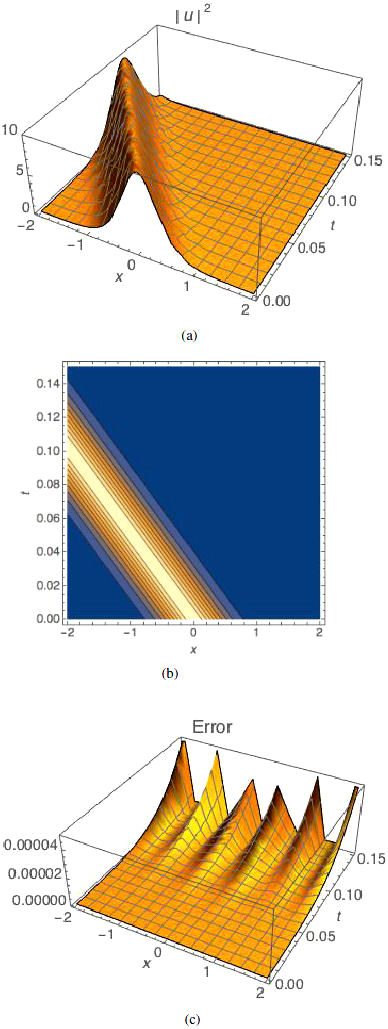
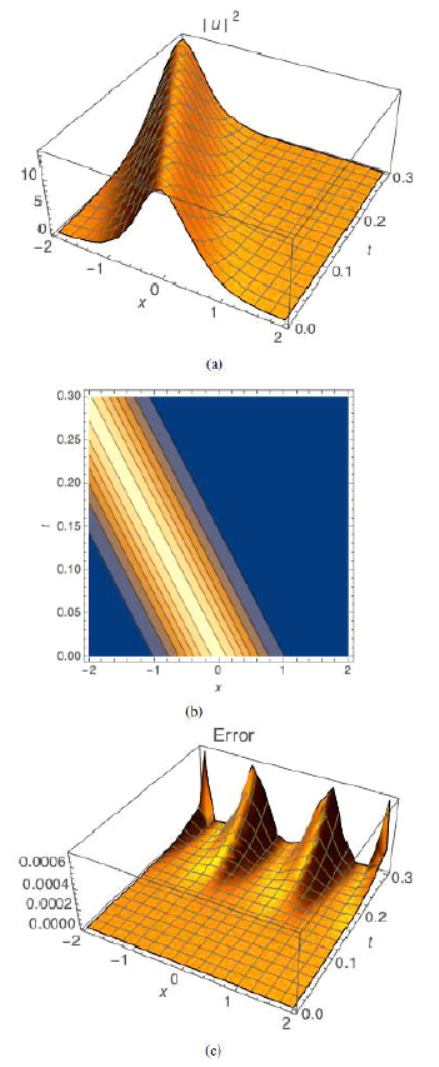

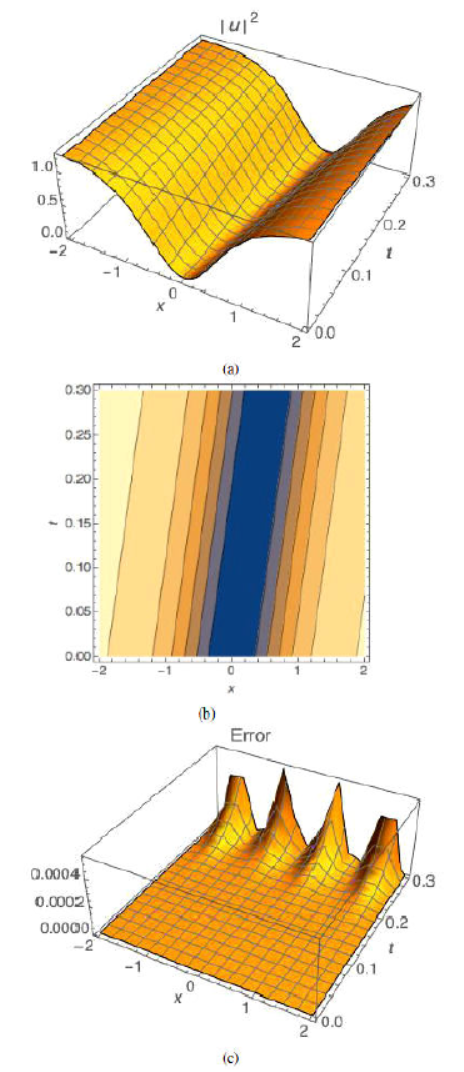











 nueva página del texto (beta)
nueva página del texto (beta)

